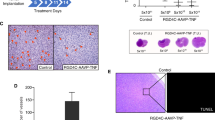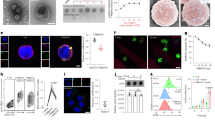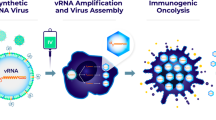Abstract
Targeted gene transduction to specific tissues and organs through intravenous injection would be the ultimate preferred method of gene delivery. Here, we report successful targeting in a living animal through intravenous injection of a lentiviral vector pseudotyped with a modified chimeric Sindbis virus envelope (termed m168). m168 pseudotypes have high titer and high targeting specificity and, unlike other retroviral pseudotypes, have low nonspecific infectivity in liver and spleen. A mouse cancer model of metastatic melanoma was used to test intravenous targeting with m168. Human P-glycoprotein was ectopically expressed on the surface of melanoma cells and targeted by the m168 pseudotyped lentiviral vector conjugated with antibody specific for P-glycoprotein. m168 pseudotypes successfully targeted metastatic melanoma cells growing in the lung after systemic administration by tail vein injection. Further development of this targeting technology should result in applications not only for cancers but also for genetic, infectious and immune diseases.
This is a preview of subscription content, access via your institution
Access options
Subscribe to this journal
Receive 12 print issues and online access
$209.00 per year
only $17.42 per issue
Buy this article
- Purchase on Springer Link
- Instant access to full article PDF
Prices may be subject to local taxes which are calculated during checkout



Similar content being viewed by others
References
Nicklin, S.A. & Baker, A.H. Tropism-modified adenoviral and adeno-associated viral vectors for gene therapy. Curr. Gene Ther. 2, 273–293 (2002).
Muller, O.J. et al. Random peptide libraries displayed on adeno-associated virus to select for targeted gene therapy vectors. Nat. Biotechnol. 21, 1040–1046 (2003).
Martin, K. et al. Simultaneous CAR- and alpha V integrin-binding ablation fails to reduce Ad5 liver tropism. Mol. Ther. 8, 485–494 (2003).
Sandrin, V., Russell, S.J. & Cosset, F.L. Targeting retroviral and lentiviral vectors. Curr. Top. Microbiol. Immunol. 281, 137–178 (2003).
Martin, F., Chowdhury, S., Neil, S., Phillipps, N. & Collins, M.K. Envelope-targeted retrovirus vectors transduce melanoma xenografts but not spleen or liver. Mol. Ther. 5, 269–274 (2002).
Jiang, A. & Dornburg, R. In vivo cell type-specific gene delivery with retroviral vectors that display single chain antibodies. Gene Ther. 6, 1982–1987 (1999).
Han, X., Kasahara, N. & Kan, Y.W. Ligand-directed retroviral targeting of human breast cancer cells. Proc. Natl. Acad. Sci. USA 92, 9747–9751 (1995).
Marin, M. et al. Targeted infection of human cells via major histocompatibility complex class I molecules by Moloney murine leukemia virus-derived viruses displaying single-chain antibody fragment-envelope fusion proteins. J. Virol. 70, 2957–2962 (1996).
Nilson, B.H., Morling, F.J., Cosset, F.L. & Russell, S.J. Targeting of retroviral vectors through protease-substrate interactions. Gene Ther. 3, 280–286 (1996).
Somia, N.V., Zoppe, M. & Verma, I.M. Generation of targeted retroviral vectors by using single-chain variable fragment: an approach to in vivo gene delivery. Proc. Natl. Acad. Sci. USA 92, 7570–7574 (1995).
Valsesia-Wittmann, S. et al. Modifications in the binding domain of avian retrovirus envelope protein to redirect the host range of retroviral vectors. J. Virol. 68, 4609–4619 (1994).
Boerger, A.L., Snitkovsky, S. & Young, J.A. Retroviral vectors preloaded with a viral receptor-ligand bridge protein are targeted to specific cell types. Proc. Natl. Acad. Sci. USA 96, 9867–9872 (1999).
Roux, P., Jeanteur, P. & Piechaczyk, M. A versatile and potentially general approach to the targeting of specific cell types by retroviruses: application to the infection of human cells by means of major histocompatibility complex class I and class II antigens by mouse ecotropic murine leukemia virus-derived viruses. Proc. Natl. Acad. Sci. USA 86, 9079–9083 (1989).
Kasahara, N., Dozy, A.M. & Kan, Y.W. Tissue-specific targeting of retroviral vectors through ligand-receptor interactions. Science 266, 1373–1376 (1994).
Zhao, Y. et al. Identification of the block in targeted retroviral-mediated gene transfer. Proc. Natl. Acad. Sci. USA 96, 4005–4010 (1999).
Akporiaye, E.T. & Hersh, E. Clinical aspects of intratumoral gene therapy. Curr. Opin. Mol. Ther. 1, 443–453 (1999).
Cavazzana-Calvo, M. et al. Gene therapy of human severe combined immunodeficiency (SCID)-X1 disease [see comments]. Science 288, 669–672 (2000).
Aiuti, A. et al. Correction of ADA-SCID by stem cell gene therapy combined with nonmyeloablative conditioning. Science 296, 2410–2413 (2002).
Morizono, K., Bristol, G., Xie, Y.M., Kung, S.K. & Chen, I.S. Antibody-directed targeting of retroviral vectors via cell surface antigens. J. Virol. 75, 8016–8020 (2001).
Wang, K.S., Kuhn, R.J., Strauss, E.G., Ou, S. & Strauss, J.H. High-affinity laminin receptor is a receptor for Sindbis virus in mammalian cells. J. Virol. 66, 4992–5001 (1992).
Klimstra, W.B., Ryman, K.D. & Johnston, R.E. Adaptation of Sindbis virus to BHK cells selects for use of heparan sulfate as an attachment receptor. J. Virol. 72, 7357–7366 (1998).
Zennou, V. et al. HIV-1 genome nuclear import is mediated by a central DNA flap. Cell 101, 173–185 (2000).
Bhaumik, S. & Gambhir, S.S. Optical imaging of Renilla luciferase reporter gene expression in living mice. Proc. Natl. Acad. Sci. USA 99, 377–382 (2002).
Lois, C., Hong, E.J., Pease, S., Brown, E.J. & Baltimore, D. Germline transmission and tissue-specific expression of transgenes delivered by lentiviral vectors. Science 295, 868–872 (2002).
Heidner, H.W., McKnight, K.L., Davis, N.L. & Johnston, R.E. Lethality of PE2 incorporation into Sindbis virus can be suppressed by second-site mutations in E3 and E2. J. Virol. 68, 2683–2692 (1994).
Allen, P.J. & Coit, D.G. The role of surgery for patients with metastatic melanoma. Curr. Opin. Oncol. 14, 221–226 (2002).
Ambudkar, S.V., Kimchi-Sarfaty, C., Sauna, Z.E. & Gottesman, M.M. P-glycoprotein: from genomics to mechanism. Oncogene 22, 7468–7485 (2003).
Berger, W. et al. Intrinsic MDR-1 gene and P-glycoprotein expression in human melanoma cell lines. Int. J. Cancer 59, 717–723 (1994).
Cameron, M.D. et al. Temporal progression of metastasis in lung: cell survival, dormancy, and location dependence of metastatic inefficiency. Cancer Res. 60, 2541–2546 (2000).
Sawai, K. & Meruelo, D. Cell-specific transfection of choriocarcinoma cells by using Sindbis virus hCG expressing chimeric vector. Biochem. Biophys. Res. Commun. 248, 315–323 (1998).
Lehrman, S. Virus treatment questioned after gene therapy death. Nature 401, 517–518 (1999).
Barry, S.C. et al. Lentivirus vectors encoding both central polypurine tract and posttranscriptional regulatory element provide enhanced transduction and transgene expression. Hum. Gene Ther. 12, 1103–1108 (2001).
Bunting, K.D., Galipeau, J., Topham, D., Benaim, E. & Sorrentino, B.P. Transduction of murine bone marrow cells with an MDR1 vector enables ex vivo stem cell expansion, but these expanded grafts cause a myeloproliferative syndrome in transplanted mice. Blood 92, 2269–2279 (1998).
Acknowledgements
We thank E.S. Withers-Ward and L. Lowe for manuscript preparation, S. Gambhir and D. Stout for supporting in vivo imaging, S. Cole and M. Sato for technical assistance with real time PCR, D. Baltimore, W. Osborne, B. Sorrentino, P. Charneau and M. Miyasaka for providing reagents, and V. Hearing, S. Leong and T. Miyamoto for assistance with histological analysis. This work was supported by US National Institutes of Health grants CA-92194, AI039975, AI028697 (UCLA CFAR).
Author information
Authors and Affiliations
Corresponding author
Ethics declarations
Competing interests
The authors declare no competing financial interests.
Supplementary information
Supplementary Fig. 1
Schematic representation of FUhLucW, FUIntronRW and CCRMDRsc1 (PDF 606 kb)
Supplementary Fig. 2
Anti-SINDBIS virus antibody blocked non-specific background infectivity of the ZZ SINDBIS pseudotyped lentiviral vector. (PDF 762 kb)
Supplementary Fig. 3
The m168 pseudotyped lentiviral vector demonstrates a higher specificity of infection in melanoma cell in vitro. (PDF 741 kb)
Supplementary Fig. 4
Expression of human P-glycoprotein on the surface of cells isolated from metastatic tumors used in the in vitro luciferase and PCR assay. (PDF 676 kb)
Supplementary Fig. 5
Immunohistochemical analysis of metastasized tumors targeted by FUGW (m168) with anti-P-glycoprotein. (PDF 981 kb)
Supplementary Fig. 6
Analysis of gene transduction in liver and spleen. (PDF 816 kb)
Supplementary Table 1
Analysis of properties of mutants (PDF 34 kb)
Rights and permissions
About this article
Cite this article
Morizono, K., Xie, Y., Ringpis, GE. et al. Lentiviral vector retargeting to P-glycoprotein on metastatic melanoma through intravenous injection. Nat Med 11, 346–352 (2005). https://doi.org/10.1038/nm1192
Received:
Accepted:
Published:
Issue Date:
DOI: https://doi.org/10.1038/nm1192
This article is cited by
-
Bioinspired engineering of fusogen and targeting moiety equipped nanovesicles
Nature Communications (2023)
-
Neomorphic DNA-binding enables tumor-specific therapeutic gene expression in fusion-addicted childhood sarcoma
Molecular Cancer (2022)
-
Genetic in vivo engineering of human T lymphocytes in mouse models
Nature Protocols (2021)
-
Improving Molecular Therapy in the Kidney
Molecular Diagnosis & Therapy (2020)
-
Roles of phosphatidylserine exposed on the viral envelope and cell membrane in HIV-1 replication
Cell Communication and Signaling (2019)



